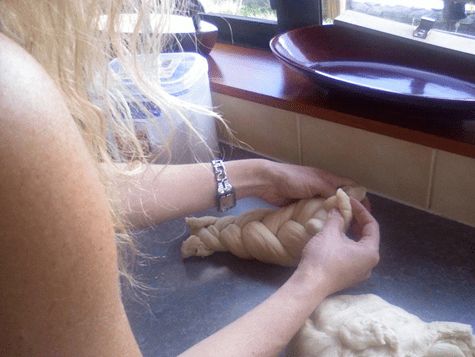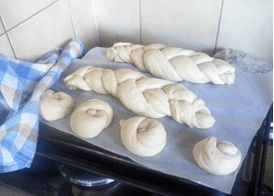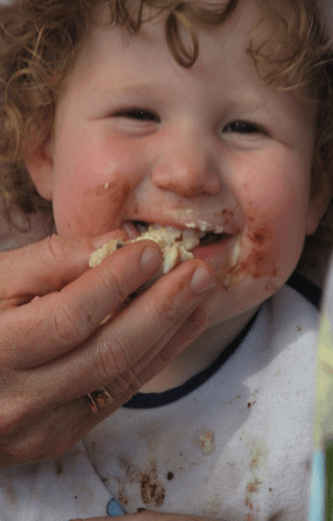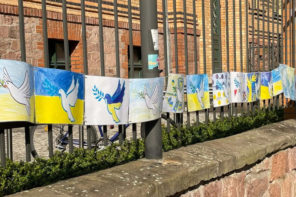One Wednesday afternoon, about four years following my family’s migration from Israel to New Zealand, I was gripped by a sudden urge to bake “challah” (The Friday night Jewish bread for the ritual of welcoming the Shabbat). Longing to return to the warmth and sunshine of Israel on that wintery day, I opened a recipe collection that I had received from my two children’s kindergarten teacher in Israel. Turning to the recipe for challah, I was reminded of the small, almost bite-sized challah sprinkled with sugar that my daughter would share with us every Friday during her time at kindergarten. Usually we ate it on the trip back home, leaving crumbs on the car seats. There was not much point in saving it for the Friday night meal – since as secular Jews we only observed this practice when we visited my parents or parents-in-law. I realized that the challah my daughter baked in Israel is the last home-baked challah I had eaten.
I rejoiced in my challah that Wednesday, but the smell of the baking bread and its sweet taste evoked my tears. The sweet challah that I was eating became salty and my sobbing made it hard to finish. This experience was intensified as I looked again at the recipe collection, and found the following metaphor for the ideal family under the title ‘Recipe for a Blissful Home’. Ingredients: 2 cups of understanding, 4 cups of love, 3 cups of forgetting, 1 cup of friendship, 2 spoonfuls of hope, 4 pieces of faith, 1 barrel of joy. Method of Preparation: Mix love with understanding and add the pieces of faith wholeheartedly. Knead the kindness and patience with warmth, and sprinkle with friendship and hope. Finally, season to taste with joy and cook with the rays of the sun. Serve plentifully every day (the Hebrew source is unknown).
Reflecting on my emotive reaction precipitated laughter. I felt that I was being ridiculously sentimental as I idealized my Israeli home through the images that were instigated by baking and eating the challah. I could remember our car taking the turns on the infamously winding road at the outskirts of Jerusalem where we lived. My food journey was so powerful it took me back to the physical landscape of Israel. At the same time, despite of my awareness I could not stop my tears. I was also surprised at the intensity and the mixture of my emotions, specifically since I felt strongly toward emigrating; it had been my choice to emigrate and nothing had forced me to leave Israel barring the hope for a better future for my family.
I gathered myself and wrote an entry in my diary, describing the insatiable hunger that had pervaded my life since arriving in New Zealand. This feeling led me to eat, cook and feed others familiar home cooked foods that I had never much cared for. I found myself craving freshly cooked dishes wistfully. I specifically longed for the dishes made by my Polish-Russian family, my Egyptian and Turkish in-laws and many fresh Palestinian dishes I used to be able to buy around Jerusalem. This event made me ponder if mine was a normal reaction;
I asked myself if other Jewish-Israelis begin to bake challah following migration. Did they too increase their home cooking and feel this insatiable hunger? Did they feel flooded by these mixed and contradictory emotions when engaging with the production and consumption of food?
To answer these questions, I embarked on fieldwork in Auckland, New Zealand (2007-2011) by conducting interviews as long conversations, and participant observation (a method of study in which the researcher participates in the life of a group). I took part in the everyday lives of 25 Jewish-Israeli migrant women from various Jewish ethnicities by shopping, baking and cooking along with them, as well as by participating in many community events and analysing the popular media they used in various ways. Though the resulting ethnography (the systematic study of human culture in descriptive and analytical ways) is dotted with many moments of my self-observation and self-reflection, it is mainly based on the everyday experiences of the women in relation to six domestic food practices. The ethnography follows their logical-practical order, starting with examining the changes in their grocery shopping to cooking and baking, then casual and festive hosting, and finally dieting for weight management. As such, it is the first ethnography that conveys the complexity of women’s emotions with regard to home, food and nostalgia, specifically avoiding any further stereotyping of these women as Jewish mothers. My ethnography shows how, in making themselves and mainly family and friends feel ‘at home’ in New Zealand, the women grapple with three main Jewish-Israeli mythical figures, the popular stereotypes of the “sabra” (the native born Jewish-Israeli male), the “polania” (the Israeli equivalent of the female Yiddish Mama), and the “bashlanit” (the cooking woman who is omnipotent).
Toward the end of my study I realized that in the vast literature that relates to food and nostalgic emotions, an often quoted passage by Marcel Proust (Ά la Recherché du Temps perdu, 1913) named ‘The Madeleine moment’, epitomises how homemade baking triggers in adults an imagined journey home. More than a century ago, Proust wrote of that journey, lead him to remember his visits to his aunt in the village as a child, who dipped her Madeleine into rose blossom tea and fed it to him. I wondered; if both Proust, who is neither a Jewish woman nor a migrant, and I have had a similar nostalgic food moment, what makes the longing of peoples distinct, and on the other hand, what makes our experiences so similar.
Through reviewing the literature on migrants, food and nostalgia, I understood that what makes Proust’s and my own experience similar is the human ability to materialize through food three important realms in our identity; senses, memories and emotions. Yet by shifting my theoretical focus to question what is home for migrant women, and how they employ their nostalgic memories and emotions in everyday life, I was able to further the understanding of the human desire to belong and feel ‘at home’. I figured that this desire drives women to bring food into the ethereal and manifest their deep longing, pleasure, ambivalence, and much self-irony, as they pass their social critique toward home.
Home can be imagined as a house that is divided into different rooms, each room representing a dimension that women realise through their everyday domestic food practices and the memories, senses and emotions that engaging with food provokes.
This ‘house’ shifts to a new cultural context after migration. The ‘house’ is obviously not ruined or demolished by international migration, but shifting it leads to transformations both in its exterior and in the interior design of each room. In my study I examined what happens to, and in, each of the ‘rooms’ or dimensions in women’s everyday experiences of reconstituting home. In examining how and why these transformations occur I ended up looking into the ways Jewish-Israeli women negotiate social boundaries with lands and people, realizing five dimensions of home: homelands, ancestral spaces of homes that materialise kinship relationships between four generations (grandmothers, mothers, the women themselves and their children), homes as communal places of belonging, homes as spiritual Jewish and traditional sites, and homes as the personal feminine body.
To illustrate what makes Proust’s and my own account, and those of the women in my study so different, I venture into a short extract from my ethnography based on the experience of Nellie, tracing the reason for the patterned behaviour of women. Nellie is a Jewish-Israeli woman of Moroccan descent married to an Ashkenazi Jewish-Israeli man. During a visit to my house in Auckland, Nellie and I talked about foods that she liked and longed for since arriving in New Zealand. She had begun baking challah regularly similarly a third of the women in the study. In addition as a Moroccan women Nellie also savoured the taste of her mother’s couscous and the manual technique of rolling the damp semolina to make it. Her paternal and maternal grandmothers made couscous distinctly different to her mother’s and her own, and she loved all of their beautiful flavours, textures and aesthetics. When talking about her childhood home in a northern township in Israel, Nellie painted a picture of piety; laying her curls on her mother’s lap and her unwavering devotion. Nellie described her mother’s cooking talent by stating that she was able to sell her baking to supplement the family income. She portrayed her mother with great pride as a triumphant survivor and skilful improviser against poverty who was also renowned for her couscous. Describing her mother’s self-sacrifice in home cooking, Nellie remembered her feeding the family and guests lavish meals from big pots while abstaining in order to ensure that the food would not run out. Nellie also claimed that to remain slim and pretty, her mother smoked, reducing her appetite to avoid eating. She recalled her mother teasing her on her last visit to New Zealand for using ‘Barbie doll pots’, small and elegant in size and shape compared with her own big and generous pots. The cooking pots represented motherly love according to their size; the bigger the pot, the more love was materialized. I asked Nellie about what mystified me; why would she feel nostalgic toward the poverty of her childhood? Nellie explained that her longing is for a time that will never return; the relative simplicity and worry-free life of a child, and the intimacy she shared with her mother, which the making and eating of couscous symbolized.
But her idealization of the past intensified her expression of the social tensions regarding home that materialized through food, mainly in relations to gender, ethnicity and class differences. For example, her mother cooking food without written recipes materialized the fact that she is a “villager” that is less educated than her father who had immigrated to Israel from a large urban centre in Morocco. Nellie remembered her father’s authority as daunting. Moreover, Nellie mocked her Ashkenazi mother-in-law for being a career woman that never had time to learn to cook. She also noted scornfully that her parents-in-law never accepted her on equal terms and always looked down on her. To contest the Zionist hierarchy of ethnicity and class within the family she had set-up, Nellie argued that the infamous Ashkenazi (East and Central Jewish communities) cuisine of gefilte fish is inferior to the Moroccan-Mizrahi (Middle-Eastern and Arab-Jewish communities) cuisine of her home.
Like Nellie and myself, other women in my study began recreating dishes of close female kin, emulating a feeling of being ‘at home’ that materialized the connection with female kin; mainly mothers, mothers-in-law, grandmothers and aunts.
Homemade dishes and especially baking turned into metonyms of these female kin.
Cooking and eating these foods expressed the women’s love and respect toward their kin as they passed on this culinary knowledge to their children; ‘cooking’ their future memories. Again like Nellie, women who formed tense relationships with their mothers or mothers-in-law, regardless of their Jewish ethnicity, often ‘skipped’ a generation and began recreating the dishes of their grandmothers. For example, in Nellie’s food memories familial tensions were commonly manifested through disgust such as toward gefilte fish, thereby expressing critique toward Ashkenazi cooking and defying the dominance of her parents-in-law.
Through cooking iconic foods of the various Jewish ethnicities like gefilte fish and couscou, remembering and eating them nostalgically, the women materialized long-lasting connections with more distant Jewish homelands of previous Jewish generations such as Poland, Morocco and Iraq, depending on the ethnic origins of their close female kin. Similarly, just as my route passed through the landscape of Israel, so did their nostalgic roads, unlike the memories of other Jewish migrants groups around the world. In addition, these imagined routes specifically manifested strong remnants of the Zionist social hierarchy and the Palestinian-Israeli conflict. Thus the nostalgic emotions of Jewish-Israeli women conveyed not only longing and the pleasures of remembering, cooking and eating, but also expressed any tensed political, gendered, ethnic and kinship relationships through deep ambivalence.
For a while I wondered about the place of ambivalence in women’s nostalgia as exemplified here. I knew Nellie was fond of baked foods. On that visit I offered her coffee and Egyptian shortbread cookies called “Menena”, which I had made earlier, following my Egyptian mother-in-law’s recipe. These cookies are usually filled with dates, walnuts and cinnamon, and dusted with icing sugar. I had eaten quite a few Menena earlier, shortly after they came out of the oven. Hence I did not partake in eating the Menena with Nellie. Upon realizing this Nellie smirked and berated me, “you bastard, you just want me to gain weight, luring me with that cinnamon of yours and tempting me to eat”. I laughed at her use of ‘bastard’ as an endearment. However, rather than enjoy the Menena wholeheartedly, my offer evoked a recount of several ambivalences. Nellie said she understood that as children, eating bread was meant to fill them up and this was the main reason for the spicy rich sauce in many of her mother’s dishes; encouraging them to dip in the bread. But as a woman now she regarded bread as “fattening” and threatening with weight gain similarly to other types of baking. Nellie confessed that she avoids looking in the mirror at her naked body, as she hates it, finding only the faults.
As our conversation went on, I asked Nellie of her first encounter with the local green lipped mussels that New Zealand is famous for. Many secular Jewish-Israelis regard the consumption of crustaceans not only as sophisticated by suggesting high class through an association with French cuisine, but also as indication of high economic class. The consumption of crustaceans therefore is embraced as part of their newly found connection with the rich sea waters of New Zealand and becomes a positive marker of this new homeland in their eating. Nevertheless Nellie stated: “I hate these rubbery things; it is enough for me to look at them to see all that disgusting hair sticking out to think of vaginas”. When relating to hairy mussels as analogous to vaginas I felt that Nellie directed her critique toward women and me specifically. She had noted my hairy arms earlier that visit, once we were seated in my living room, and suggested that when I come over to her house she would depilate them. I refused and said: “thank you, but I’m actually attached to my bodily hair; it keeps me warm in the cold New Zealand winters”. Her idea that mussels are like vaginas prompted me to tease her fondly by saying “why don’t you just pluck out the mussels’ hair, and enjoy eating them anyway; after all there are few better mussels than in New Zealand!” Nellie’s instant reaction was “uooo… you’re disgusting!” as she squealed “how can you even suggest this to me?”, smacking my arm jokingly. Nellie’s disgust at eating mussels-vaginas had been instantly transferred to me, who provoked disgust by suggesting proximity to the image and texture that threatened her.
Today, in the anthropology of home, we are greatly aware of the powerful discourses that create analogy between women, the family and the motherland, often demanding singular loyalties. We also know that nostalgic journeys home are inseparable from the human experience and in particular the migrant experience, whereby people taking this route aim at re-establishing a sense of being ‘at home’, rather than blocking their integration into their chosen-new homelands.
My central ideas derive from the understanding that women, like other humans, traverse time and space in powerful and sensate ways through their food nostalgia, which triggers and is triggered by their senses, emotions, imagination and memory.
My new idea is that longing, pleasures and ambivalence are not only integral part of women’s nostalgia, but also used to express social critique toward home. What is more, my work establishes the new idea that migrant women live, imagine and return in longing to multiple notions of home, since home is a multidimensional space that they realise through the relationships they negotiate in their food production and consumption. Their ambivalence in particular is a vital means in overcoming the common adversities that migrants face by expressing important social commentary regarding home, which instigates pleasure and evokes humour and self-irony. Self-irony is an enactment of identity (not performance) that is referential and situational, since it is instigated through the life experience of the women in New Zealand. For example in self-irony the women make jokes about hurtful matters normalises, what the women often call their “obsession”, “malady”, “fault” and “addiction” with regard to cooking and specific home cooked dishes and baking. Their “faults” concerning food production and consumption turn into feminine identity markers that the women recognise as normal cultural differences in New Zealand. This kind of self-irony is raised by discussing for example home cooking and baking, suggesting that the women remember who they are and where they come from. In addition, their self-irony articulates who they do not wish to become, namely what they perceive to be the behaviour of “neglectful” or “over-caring” women, which are common stereotypical attributes for females in the Israeli society.
Anthropological research that focusses on supposedly trivial matters has the potential to raise disregarded but profound questions, such as what is home for women. As a fundamental part of any material culture, researching the changes women engender in their food production and consumption when becoming migrants, opens up new ways of understanding complex questions, such as how and why humans, following their physical mobility, reformulate the relationships with the lands and the people they wish to call ‘home’.
Hadas Ore – 3 Minute Thesis 2013
Full original title of the post: Nellie’s green lipped mussels and how to revisit the relations between women, home, food and nostalgia












